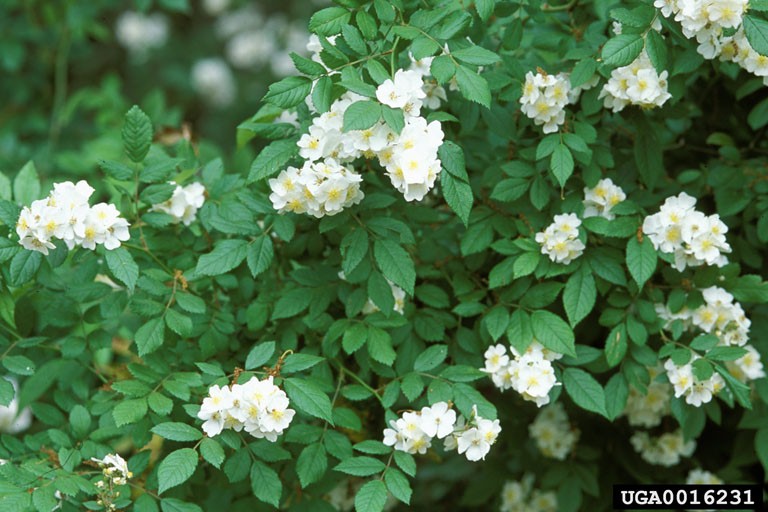Rosa multiflora
Multiflora Rose / Rambler Rose
Synonyms: Rosa cathayensis
Order: Rosales
Family: Rosaceae

Photographer: James H. Miller
Source: USDA Forest Service
Description
Rosa multiflora a thorny, perennial shrub that can reach 10-15 feet tall and up to 13 feet wide. Leaves are alternate and pinnately compound growing about 4 inches long. Leaves are attached to long, arching stems that are covered in recurved thorns. Fragrant flowers are usually white but sometimes pink and are an inch in diameter with five petals. Clusters of rose hips (fruit) become bright red when mature, then leathery in the fall. However, the rose hips never fall off or open to release their seven seeds, they must be consumed for the seeds to spread. Long- distance seed dispersal is accomplished by winter-feeding birds such as Cedar Waxwings, Mockingbirds, Red-winged Blackbirds, American Robins and Starlings.
Ecological Threat: Infestations of multiflora roses reduced land values of agricultural, forestry and recreational areas. Also, when used as a hedge between crops it may reduce crop yield because it is taking nutrients away from the crops.
Biology: Rosa multiflora reproduces by sexually and vegetatively. One large mature plant can have as many as 500,000 seeds (contained within rose hips) per year. Seeds are carried long distances by birds and when the rose hips are consumed, the gastric juices help germinate the seeds. This means that once the seeds are excreted they are able to implant in the ground and form seedlings. Deer also eat the rose hips and are another pathway for germination. Seeds can remain viable up to 20 years. Seedlings grow close to the ground for the first 2 years.
History: This rose was intentionally introduced to the United States several times since the late 1700s; mainly as a garden plant or as an ornamental rose rootstock. However, it was in the 1930s, that the U.S. Soil Conservation Service recommended the multiflora rose to protect soil from erosion and to use it as living fences for livestock. Over 14 million free cuttings were planted in North Carolina and 20 million in Virginia. It has now spread to over 40 states and is considered highly invasive is the Eastern United States.
U.S. Habitat: Old fields, agricultural land, pastures, roadsides, hillsides, swamp margins and open woods. However, it cannot tolerate areas with standing water.
Distribution
Native Origin: Eastern Asia
U.S. Present: AL, AR, CA, CO, CT, DC, DE, FL, GA, IA, IL, IN, KS, KY, LA, MA, MD, ME, MI, MO, MN, MS, NC, NE, NH, NJ, NM, NY, OH, OK, OR, PA, RI, SC, TN, TX, UT, VA, VT, WA, WI, WV
Resembles/Alternatives
With more than 80 species of roses (native or invasive), established in the United States the multiflora rose can easily be confused for some of the other species. A few species usually confused are the Macartney rose and the Cherokee rose; both are invasive species also. The Macartney rose differs by having larger leaves and the stems have straight and recurved thorns. The Cherokee rose has a three-leaflet compound leaf and only has white flowers for a short period of time in early spring. Pasture rose, climbing prairie rose, swamp rose, prickly rose, smooth rose and Virginia rose are native species that can be confused for Rosa multiflora.
Management
Rosa multiflora can be controlled by physical, chemical and biological means; but all strategies have their limitations. The multiflora rose can only be controlled by physical means when they are seedlings. Pulling or repeated mowing will prevent the establishment of seedlings; but it has to be done 3-6 times a growing season for up to 4 years. Burning has not been tried on multiflora rose but has been successful in Texas when treating the Macartney rose.
All chemical control strategies requires follow-up because of the 20 year seed bank. Foliar sprays work is repeated for two years and application of herbicides to freshly cut stumps is also very effective. However, picloram is not effective if applied directly to soil.
Multiflora rose is tolerant to many native insects and diseases and any introduced control must not damage ornamental roses. There are three established biological controls that are possibilities. Larvae of the European rose chalicid (Megastigmus aculeatus var. nigroflavus), a small wasp, hatches within the seeds and feeds on them. After overwintering in the empty seeds, adults emerge the next summer to then lay eggs and continue the cycle. Unfortunately, this wasp species is not widespread because they are not strong fliers. The second biological control is the rose stemgirdler (Agrilus aurichalceus). The larvae burrow beneath the bark and girdle the stems, which then kills the stem above the girdle. However, they are also known to affect blackberries and raspberries. Finally, the rose rosette disease, which is native to North America and is spread by the mite (Phyllocoptes fructiphilus); causes flowers to develop improperly. This pathogen has proven fatal to multiflora rose from the Great Plains to Maryland. Alas, the drawback is that this virus is detrimental to ornamental rose species and it can be spread by air currents or grafting affected plants.
References
Hipkins, P.L., W.E. Chappell, J.S. Coartney, and M.L. Link. 1980. The use of plant growth regulators to prevent the spread of multiflora rose. Abs., Proceeding 33rd Annual Meeting Southern Weed Science Society. p. 158.
Woodward, Susan L., and Joyce Ann. Quinn. 2011. Multiflora rose. Encyclopedia of Invasive Species: From Africanized Honey Bees to Zebra Mussels. Santa Barbara, CA: Greenwood. 522-526. Print.
Internet Sources
http://extension.entm.purdue.edu/CAPS/pestInfo/multifloraRose.htm
http://www.ppws.vt.edu/scott/weed_id/rosmu.htm
http://www.weedimages.org/browse/detail.cfm?imgnum=1325096
http://dnr.state.il.us/Stewardship/cd/images/768x512/0002059.jpg
http://entnemdept.ufl.edu/creatures/ORN/ph_fructiphilus.htm
 Texas Invasive Species Institute
Texas Invasive Species Institute